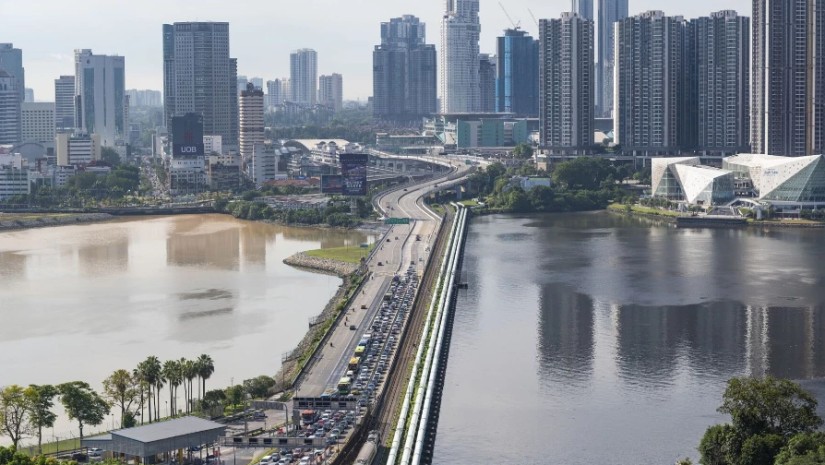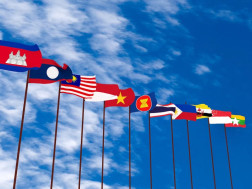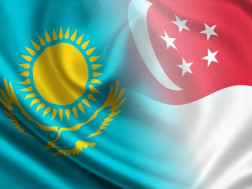The global financial market speaks a language and smart money should pay attention. Global markets run on “narratives”, most investors are aware of the term AI for artificial intelligence.
Among banks & brokers and where to make money in terms of asset allocation AI increasingly stands for ASEAN & India.
While Mr. Modi’s India or Bharat has already become the darling of global investors. India’s Sensex market is up +10% , strongly outperforming Mr. Xi’s China where the Shenzhen composite index is down -16.77%. in terms of global asset allocation ASEAN might increasingly get more recognition and investor interest. Several ASEAN countries have successfully practiced bamboo diplomacy to navigate more challenging geopolitics and the potential impact of the USA November election and a possible Trump 2.0 presidency. Despite of who is in power in Washington over the next 4 years, ASEAN most probably will manage well and do well for investors.
As of 2024, the combined GDP of ASEAN countries is approximately $3.86 trillion, with a population of about 686 million people. This gives the ASEAN region a GDP per capita of around $5,633. In comparison, India's GDP in 2024 is approximately $3.94 trillion, with a GDP per capita of about $2,730. This places ASEAN's overall economic size slightly below India's, but with a higher average income per person across the region.
Year-to-date the STI strait times index is 0.15% while the Malaysia KLCI index is +10.45%
EWS iShares MSCI Singapore is the republic of Singapore country ETF on the New York stock exchange, while EWM is the iShares MSCI Malaysia truly Asia ETF. In USD terms Singapore so far, this year has underperformed Malaysia by -10.26%. source: Bloomberg.
Mahathir Mohamad and Lee Kuan Yew were two of the most influential leaders in Southeast Asia, each playing pivotal roles in the development of their respective countries, Malaysia and Singapore.
The relationship between Tun Mahathir and Mr. Lee was complex, marked by both cooperation and rivalry. As leaders of neighbouring countries with shared histories, they often found themselves in conflict over various issues, but they also had mutual respect for each other’s leadership and nation-building achievements.
As the current king of Malaysia is the sultan of Johor, the state neighbouring Singapore and the island state has new leadership under the so called G4. The term "G4 leadership" in Singapore typically refers to the fourth generation of political leadership within the ruling People's Action Party (PAP). This group, also known as the 4G leaders, consists of the younger ministers who are expected to take over the reins from the current third-generation leaders, such as Prime Minister Lee Hsien Loong.
Singapore has moved from 3rd world to 1st and has now a widely accepted passport and the island’s GDP per capita is approximately $84,734 in current U.S. dollars. Malaysia's GDP per capita is approximately $12,000 in current U.S. dollars. Singapore and Malaysia and in particular Johor as hinterland for Singapore could further enhance the investment story of ASEAN. Data centres in Malaysia and in JB has become one market narrative, that smart money should pay attention to.
Both Singapore and Malaysia equities underperformed global equities MSCI world over the last 5 years. URTH MSCI world last 5 years +63.52% while Singapore -16.68% and Malaysia – 14.44%
Year-to-date 2024, Malaysia has outperformed Singapore by +10.26%. Total return for global equities so far this year +9.92% while Singapore ETF is +3.91% and the Malaysia ETF is +14.18%. these are USD united states dollar returns.
As of mid-2024, the market capitalization of Singapore's stock market stands at approximately USD 590.8 billion. Meanwhile, Malaysia's stock market has a market capitalization of around USD 405.3 billion.
Singapore has approximately 670 listed companies on the Singapore Exchange (SGX). Malaysia has around 940 companies listed on Bursa Malaysia.
Singapore recently introduced a MAS central bank task force to increase liquidity in the island state’s stock market. MAS singapore among central banks globally is unique in the sense thar MAS is both a central bank and ministry of Finance in addition to being a regulatory authority.
The republic of Singapore market trades at a valuation of P/E 10.54x and a 12-month dividend yield of 5.35%.
in Singapore the communications sector comprised of incumbent telecom SingTel is the best performing sector with +21.4%, followed by industrials with +15.3%. consumer staples with -12.2% and Energy sector with -39.8% are the worst performing sectors of the city state.
Singapore telecom with +14.98% is the 2nd best performing stock in Singapore ahead of DBS, the DEVELOPMENT bank of Singapore.
DBS stock year-to-date has appreciated by +11.88% and the bank dividend yield stands at 5.6% and DBS pays investors quarterly. Next ex-dividend date is 11/12/24.
Analyst ratings on DBS currently stand at BUY 66.7% hold 27.8% and sell 5.6%. the analyst community average analyst 12 month. The analyst community expects potential gain of +16.6% from current level on a 12-month view. The development bank in line with the political leadership of Singapore recently announced a top management change. Ms Tan su shan was selected to become CEO of the bank succeeding veteran banker Mr. Piyush Gupta at the helm of DBS. Allegedly in the old days at the development bank of the small red dot, they said, if it is good for Singapore they will do it. Under Mr. Gupta’s leadership, DBS has grown significantly and has been recognized for its innovation and digital banking initiatives. Mr. Piyush Gupta is widely regarded for transforming DBS into a leading financial services group in Asia, that now even has a “private” banking offering.
Singapore Telecom was once run by minister Mentor LKY Lee Kwan Yew’s second son Mr. Hsien Yang
Lee Hsien Yang served as the Chief Executive Officer (CEO) of Singtel from 1995 to 2007. During his tenure, he oversaw significant growth and expansion of the company, both domestically and internationally. Under his leadership, Singtel transformed from a primarily local telco into a regional telecommunications giant with substantial investments in mobile operations across Asia and Australia. Singtel current valuation stands at P/E16.8 x and a dividend yield of 4.61%.
Singtel’s 3-year dividend growth rate stands at +20.43%. Singtel pays investors semi-annually and the next ex dividend date is 12/19/24. The analyst community expects a 12-month average analyst TP target price of SGD 3.47, implying (potential) gain of +22.2% from current levels and the 2nd best performing stock in the island STATE.
Maybank of Malaysia and its Singapore entity Maybank Singapore is said to be the 4th largest retail bank in Singapore. For global investors however MAY Or Maybank is increasingly a play on ASEAN as Maybank tries to position itself as a true ASEAN bank.
Malayan banking Berhard has its main listing on the KLCI and the bank’s current valuation stands at P/E12.44 x with a dividend yield of 5.88%.
Maybank is trading close to its 12-month average analyst TP of MYR 10.38, implying limited capital gains of +1.8% from current levels.
In Singapore, a new review group with representatives from both the private and public sectors will propose measures to revitalise Singapore’s struggling stock market.
Announced by the Monetary Authority of Singapore (MAS) on Aug 2, the panel will be chaired by Second Minister for Finance and MAS board member Chee Hong Tat.
It is interesting to note that Singapore gained the trust of the world in terms of banking and financial centre, yet the % allocation of global investment portfolios allocated to SGX singapore exchange stocks denominated in SGD Singapore dollars is still rather small and insignificant
Singapore gained independence from Britain on August 31, 1963, as part of its merger with Malaysia. However, it became a fully independent nation on August 9, 1965, after separating from Malaysia.
Oil rich Brunei from the beginning refused to join the federation of Malaysia.
Malaysia gained its independence from Britain earlier, on August 31, 1957. This day is celebrated annually as Malaysia's National Day, also known as "Hari Merdeka." In the early days, Mr. Lee and his comrades believed the tiny island of Singapore could not possibly survive without its natural Malayan hinterland. Singapore’s entry into Malaysia began with high hopes on both sides, as Tunku Abdul Rahman depicted a glorious future for Singapore, declaring that it would become the New York of Malaysia while KL Kuala Lumpur , the capital would become its Washington DC. The elites of KL and Singapore were like the proverbial couple who slept in the same bed with different dreams, and the expulsion of Singapore from the federation of Malaysia was a question of when and not if. Singapore was part of Malaysia for a brief period of approximately two years. Singapore joined Malaysia on September 16, 1963. the Union between Singapore and Malaysia was fraught with political and economic tensions, particularly over issues like racial policies, economic disagreements, and political power-sharing. These tensions culminated in Singapore's expulsion from Malaysia on August 9, 1965
Singapore and Brunei have had a currency arrangement known as a currency interchangeability agreement since 1967. Under this agreement, the Singapore dollar (SGD) and the Brunei dollar (BND) are interchangeable at par value, meaning one can be exchanged for the other without any loss in value. This agreement reflects the close economic and historical ties between the two nations, allowing both currencies to be used interchangeably in each country.
After three years of losses, the Malaysian ringgit is outperforming its Asian peers in 2024 as the government drove policies to boost foreign investments and began rolling back subsidies to narrow the budget deficit. That’s helped to lure back interest from global funds, who poured $112 million into local Malaysian stocks this year.
Despite a strong rebound from March lows, Malaysian equities still trade at low price-to-book multiples. The index fell 25.2% from 2020 highs to its nadir but has recovered by 28.2% since. It still trades at 1.6x book, more than 1.1 standard deviations below the average since 1999. Historically, when a standard deviation of minus one has been broken, the index has bounced back 27% in the subsequent 12 months, suggesting the current rally might have more room to run.
Additionally, relative to the MSCI Emerging Markets index, Malaysia trades at a 6% discount, well off the average 15% premium since 1999. While a premium of that size may not be justified, the opportunity exists for the discount to disappear in 2H.
Malaysian equities are likely to face growth headwinds in 2H against already low expectations. Median EPS growth for the country is expected to be just 4.5% in the year ahead, vs. 12.9% for emerging markets. Expectations are particularly low in discretionary (down 22.4%) and financials (4.1%), the largest sector in the index. Conversely, health care (plus 63.7%), industrials (12.5%) and staples (11%) could lead EPS growth over the same time frame.
Johor Bahru, the capital of the Malaysian state of Johor, has been experiencing significant growth and development in recent years. Johor Bahru's strategic location near Singapore makes it an attractive destination for both businesses and residents. The city benefits from economic spillover effects, with many Singaporeans investing in real estate, shopping, and dining in Johor Bahru due to the favourable exchange rate and lower cost of living. Major infrastructure projects, including the Rapid Transit System (RTS) link between Johor Bahru and Singapore and the expansion of the Senai International Airport, enhance connectivity and attract investments. Improved transportation networks facilitate easier movement of people and goods, boosting economic activities.
The Iskandar Malaysia economic corridor, a massive development project, aims to transform Johor Bahru into a regional hub for business, education, healthcare, and tourism. Significant investments in residential, commercial, and industrial projects within Iskandar Malaysia are driving the city's growth. Johor Bahru's economy is diversifying beyond traditional sectors like manufacturing. There is growth in sectors such as tourism, education, healthcare, and services. The presence of international schools, hospitals, and shopping malls adds to the city's attractiveness.
The Malaysian government and the Johor state government have implemented policies and incentives to attract foreign investment and promote economic development. These initiatives include tax incentives, grants, and support for businesses.
Investors are encouraged to conduct thorough due diligence, seek professional advice, and consider their risk tolerance before making any investment decision in Singapore or Malaysia or in a portfolio context. Past performance is not indicative of future results, and investments can lose value. This article is for informational purposes only and does not constitute investment advice or an endorsement of any investment strategy or single security.
Rainer Michael Preiss is Partner & Portfolio Strategist at Das Family Office in Singapore























